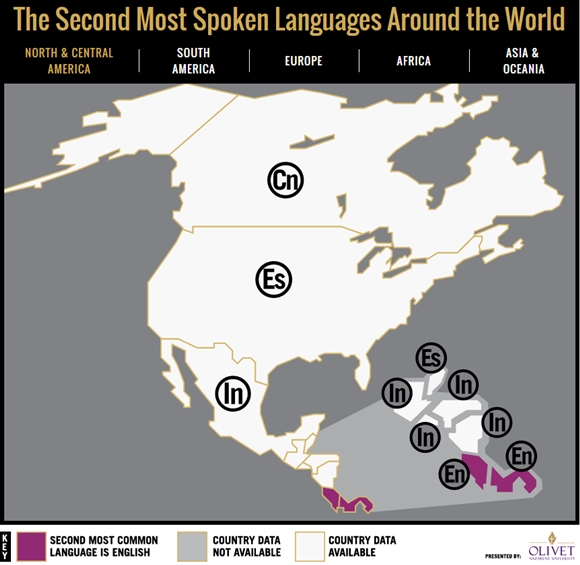Language is a gateway to understanding a country’s history, culture, and people. As TESOL teachers, exploring both the official language and the second most spoken language of a country provides unique insights into how languages shape and reflect societal dynamics. By teaching students about these linguistic layers, you open up windows into a world of cultural richness and historical depth. In this article, we will explore how researching these languages offers a deeper understanding of the places where they are spoken and how TESOL educators can incorporate this into their lessons.
Why Focus on Both the Official and Second Most Spoken Languages?
The official language of a country is often tied to its government, institutions, and national identity. However, the second most spoken language frequently reflects deeper historical narratives, such as colonization, migration, and the blending of cultures. Understanding both languages in a country can reveal its cultural diversity and the social dynamics at play.
For example, in countries like Canada, Switzerland, or South Africa, where multiple languages coexist, the relationship between the official and second most spoken language helps illustrate a more complete picture of the country’s identity and its multilingual population.
Exploring Language as a Cultural Window
- Canada: French and English
Canada is officially bilingual, with both English and French as official languages. English is the most widely spoken language, but in the province of Quebec, French dominates. The prevalence of French traces back to the colonization of Canada by France in the 16th century, before British control took over. By learning both languages, students can dive into Canada’s rich history of colonization, the resulting French-English tensions, and the modern effort to preserve bilingualism in Canadian society.- Teaching Tip: Incorporate lessons on how bilingualism in Canada influences national unity, politics, and cultural preservation. Ask students to compare how French and English are used in various regions of Canada.
- India: Hindi and English
India is a multilingual nation, with Hindi as the most widely spoken official language and English as the second most spoken language. English serves as an associate official language and a lingua franca for education, business, and government, a legacy of British colonial rule. Hindi, however, reflects India’s deep cultural roots, as it evolved from Sanskrit and other ancient languages. Together, Hindi and English reflect the unique cultural fusion of India’s past and present.- Teaching Tip: Have students explore the influence of British colonialism on the adoption of English in India. Encourage discussions about how English is viewed in post-colonial societies and how Hindi reflects India’s cultural heritage.
- South Africa: Zulu and English
South Africa recognizes 11 official languages, with Zulu being the most spoken, followed by English, which serves as the primary language of business, politics, and media. English, as a colonial language, has remained a dominant force even after the end of apartheid. Meanwhile, Zulu reflects the indigenous history and culture of South Africa’s largest ethnic group, the Zulu people.- Teaching Tip: Use South Africa’s linguistic diversity as a case study in post-colonial language policy. Explore the dynamics between indigenous languages and English, and how language ties into issues of power and identity in modern South Africa.
- Switzerland: German and French
Switzerland is a remarkable example of multilingualism, with four official languages: German, French, Italian, and Romansh. German is the most widely spoken, but French is dominant in regions like Geneva. The linguistic diversity of Switzerland is closely tied to its geography, as the country borders Germany, France, and Italy. This blend of languages reflects the peaceful coexistence of diverse cultural influences within a small geographic area.- Teaching Tip: Explore how Switzerland’s language policy promotes unity despite its linguistic diversity. You can also have students research the cultural regions of Switzerland and how language influences daily life in each region.
- Nigeria: Hausa and Yoruba
Nigeria, Africa’s most populous country, is home to over 500 languages. While English is the official language (due to British colonization), Hausa, Yoruba, and Igbo are the most widely spoken indigenous languages. English serves as the language of government and education, but indigenous languages are crucial to daily communication and cultural expression.- Teaching Tip: Ask students to research Nigeria’s linguistic landscape, focusing on the roles English and indigenous languages play in social life, politics, and education. Highlight how multilingualism reflects Nigeria’s cultural diversity.
How to Use Language Research in TESOL Lessons
- Language Maps
Have students create language maps of different countries, highlighting where the official and second most spoken languages are spoken. This visual approach helps students understand the geographic and cultural spread of languages within a country. - Language Histories
Assign students research projects on how historical events, such as colonization or migration, have influenced the development of the official and second most spoken languages in various countries. This not only teaches language but also provides context on global history and politics. - Cultural Comparisons
Have students compare how the official and second most spoken languages influence cultural practices, social norms, and identity in different regions. For instance, in Canada, how does being bilingual influence identity in Quebec versus other parts of the country? - Role-Playing Conversations
Engage students in role-playing exercises where they simulate conversations between speakers of the official language and the second most spoken language. This helps them practice communication strategies for multilingual settings and understand the importance of language in cross-cultural interactions. - Discussion of Language Policy
Discuss with students how language policies in multilingual countries can promote inclusivity or create tensions. This leads to discussions about language rights, education policies, and the preservation of minority languages.
Fun Facts About Language Diversity
- Papua New Guinea holds the title for the most languages spoken in one country, with over 800 languages in use! However, Tok Pisin and English serve as official languages to bridge communication across the country’s diverse communities.
- Luxembourg is a small country with three official languages: Luxembourgish, French, and German. Citizens are often trilingual, switching between languages depending on the context—German for newspapers, French for official documents, and Luxembourgish for everyday conversation.
- Belgium is a prime example of a country divided by language. It has three official languages: Dutch, French, and German. The country is split into linguistic regions, with Dutch dominating in the north (Flanders) and French in the south (Wallonia).
Conclusion: The Power of Language Research
Understanding the official and second most spoken languages in a country offers a powerful lens through which TESOL teachers can engage students in language learning. It provides a deeper appreciation of history, culture, and the complexities of the world we live in. By integrating language research into lessons, TESOL teachers can inspire curiosity, encourage global awareness, and make language learning a journey that goes beyond the classroom walls.
Through this approach, students not only become better English speakers but also global citizens with a richer understanding of the world’s linguistic and cultural diversity.



